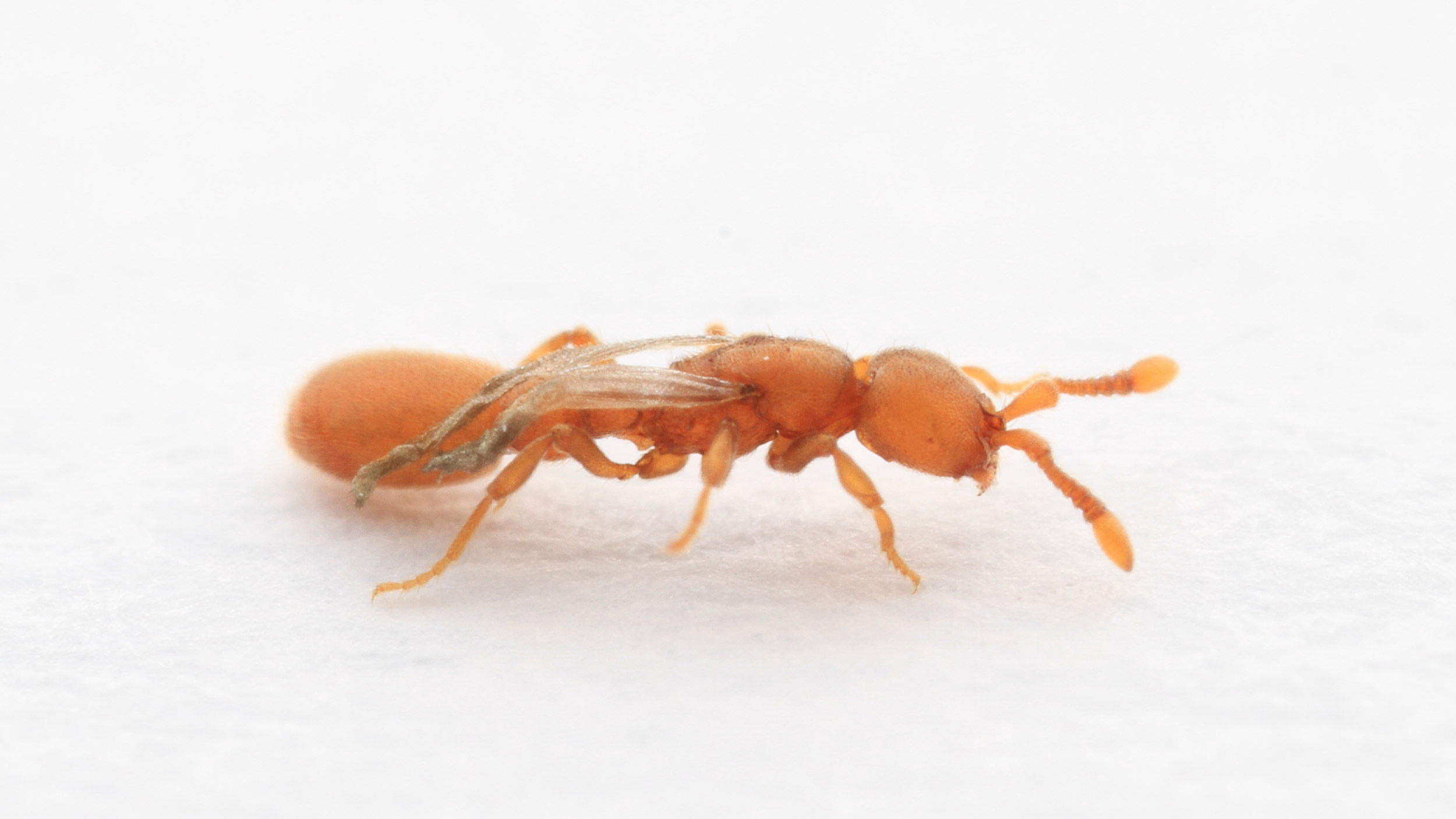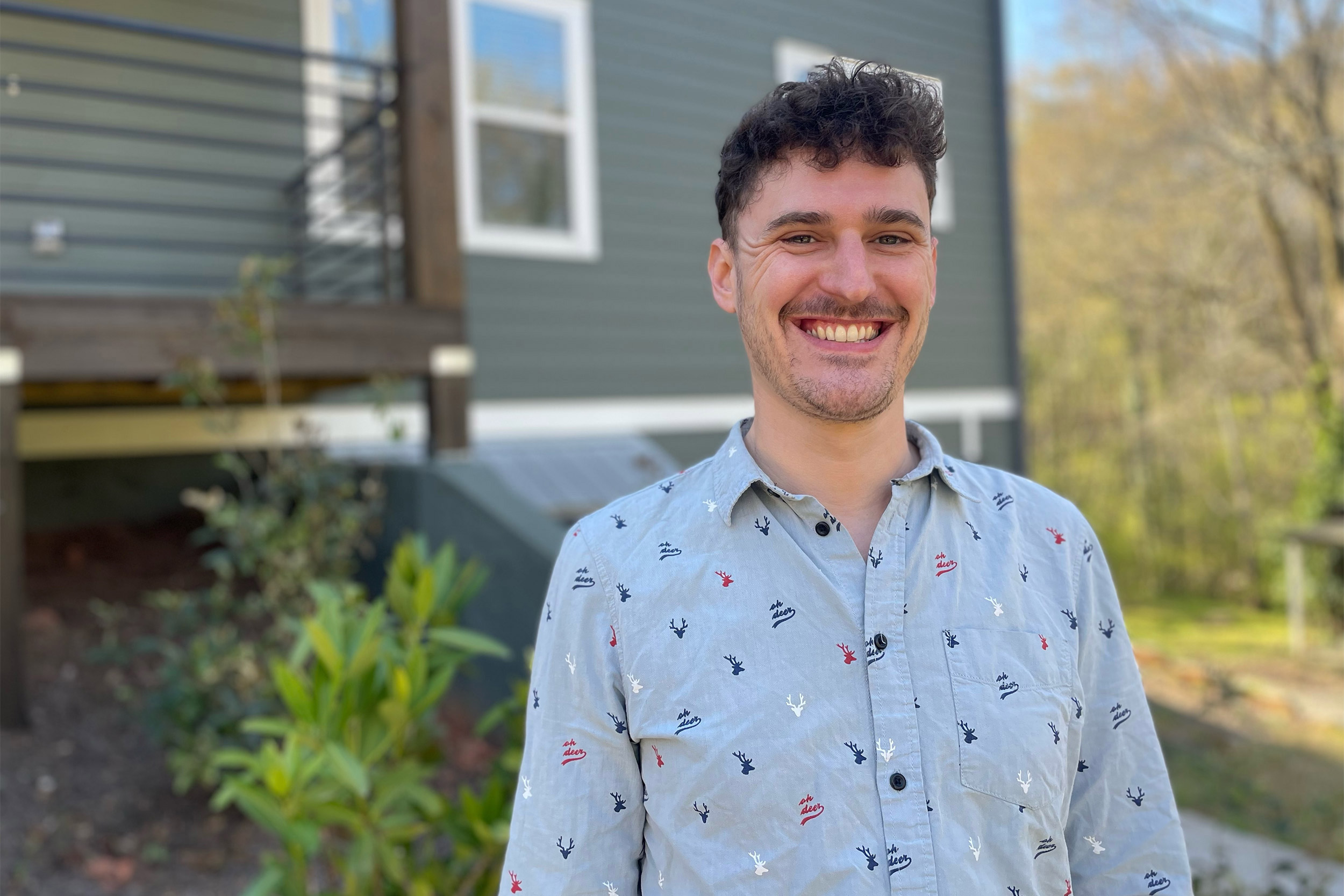Buck Trible and the case of the mutant ants

An immature queen-like mutant ant, which possess wings, flight musculature, and more well-developed reproductive and visual systems than wild-types.
Images courtesy of Buck Trible
Spontaneous mutation offers new theory about how ants evolve into social parasites, how human bodies grow
For the last five years, Waring “Buck” Trible has been having the same dream. He’s in the lab using CRISPR to tweak the genes of a wild worker ant. And poof! Like a Formicidae fairy tale, the lowly laborer becomes a queen — or queen-like, at least.
“And I start crying,” Trible said, “out of joy.”
Trible’s dream may not be reality — yet. But he and a team of researchers from Harvard and The Rockefeller University recently discovered a huge clue to the century-old mystery of why some ants become workers — the tireless minions that feed, house, and care for their colony — while others become queens — the winged, egg-laying members of a leisure class who enjoy the fruits of all that labor. The answer to this mystery may offer some insight into another seemingly unrelated one involving human development.
The clue researchers found involves a more elusive ant type: the social parasite, or a queen with no workers to exploit, which must seek out and parasitize other species to survive. In a recent paper published in Current Biology, the team reports the discovery of a queen-like mutant in a colony of clonal raider ants, a queen-free species. This spontaneous birth of a queen-like mutant contradicts former theories about how parasitic queens evolved and has wider implications.
“The way an ant becomes a worker or a queen, it’s really the same way that you get differences in tissue growth in humans between small-bodied individuals and large-bodied individuals,” said Trible, a John Harvard Distinguished Science Fellow and lead author on the paper. During adolescence, humans sprout into adult-sized bodies, and each body part, from heart to toes, somehow grows to the appropriate size. And if something goes wrong, that scaling error could cause disease or dysfunction.
“It’s a gnarly problem,” said Trible. “We really don’t know how organ size scales with body size. It’s a huge mystery.”
The queen-like mutants offered a rare opportunity to explore this mystery.
“The first mutant that breaks something can be a really powerful tool,” said Trible. If a biological process breaks, the resulting mutation is like a signpost, pointing to the tissues, cells, genes, and proteins behind it.

Back in 2015, the first queen-like mutants popped up in the lab of Professor Daniel Kronauer at Rockefeller. At first, Trible, then a graduate student in the group, and his fellow lab mates weren’t sure what they were — and, more importantly, how they got there. No one, Trible said, has ever reported seeing a queen or winged female clonal-raider ant. And yet, these odd-looking creatures had an especially revealing feature: wings or scars where their mutant wings fell off.
A few of Trible’s peers proposed these mutants resulted from some kind of environmental shock — overfeeding, perhaps, or hot temperatures. Trible had another guess: These mutants had wings and queen-like traits, but the body size of a worker.
“Something has broken where they’re supposed to be a worker, but they’re becoming a miniature queen because they can’t help it, because something isn’t working right,” he said.
Previously, biological heavyweights like Charles Darwin, William Morton Wheeler, and Harvard’s own Edward O. Wilson theorized that parasitic queen ants evolved into queen-like worker-sized ants one individual trait at a time.
A colony could get separated or divided by a river, for example. That isolation could, the biologists speculated, allow one colony to evolve those parasitic traits, passing them down to their offspring. Later, if the queens re-encountered the workers, a few could infiltrate the colony and reap the evolutionary benefits.
And yet, no one has ever found a colony full of queens — or even ants with some but not all parasitic traits — which is not surprising. Parasites cannot survive on their own. They don’t forage for food, build tunnels to protect themselves, or care for their young. If a queen-like mutant were spontaneously born into a colony of worker ants, she would have two choices, Trible said: die and go extinct, or parasitize her own kind. And Trible’s spontaneous mutants didn’t forage either; they mooched.
Trible found 14 more queen-like mutants in the lab’s colony of 10,000 ants. To prove they arose from a genetic anomaly — and not environmental stress — he bred them. All their daughters had wings, too. “That was the moment that everybody really stood up straight and took this seriously,” Trible said.
The mutants could not birth a worker ant; and if a worker reared a mutant’s egg, it, too, came out winged and queen-like. Clearly, the templates for these two castes came from their genes — or rather, their supergenes.
A supergene, like a queen starter kit, is a collection of genes inherited all at once. Using whole-genome sequencing, the researchers discovered the mutants had a mutation in one of their chromosomes — a chromosome that appears to contain a supergene. In the case of the queen-like mutants, the starter kit includes physical instructions for how to grow their odd bodies and wings as well as behavioral instructions.
The queen-like mutant’s starter kit contains about 200 genes, many of which have to do with hormones, more specifically the ant version of estrogen. Just one mutation in those genes (which encode the cytochrome p450 enzymes) can affect the ant’s shape, egg production (queens tend to lay more eggs) and parasitic behavior, said Kronauer in a Rockefeller University press release. “It can all shift in a single mutational step.”
This suggests that, instead of evolving individual traits in isolation, a queen could pop up in her host colony in one generation, fully prepared to be a parasite.
“They’re all coordinated under the same umbrella,” said Trible. That means a queen’s wings, eyes, and ovaries may grow to the appropriate queen-like size because of one set of instructions rather than separate signals. “And that’s a big deal,” Trible continued, “because that means that maybe there’s a hormone for this, maybe even in humans.”
Of course, just because queens can be born this way doesn’t mean that’s how parasites are birthed in the wild. Next, the team plans to research whether wild ant species have supergenes and if their parasitic queens are spontaneously born from larvae that would typically produce workers. In the meantime, Trible will keep dreaming that, one day, he will understand the mutant’s genetic origins well enough to recreate them in his lab.
“The big thing is just that this mutant exists at all,” Trible said. “No one has ever seen a mutant. It’s totally unprecedented.”





